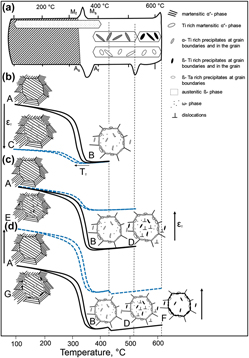Article contents
Microstructural evolution and functional fatigue of a Ti–25Ta high-temperature shape memory alloy
Published online by Cambridge University Press: 08 August 2017
Abstract

Titanium–tantalum based alloys can demonstrate a martensitic transformation well above 100 °C, which makes them attractive for shape memory applications at elevated temperatures. In addition, they provide for good workability and contain only reasonably priced constituents. The current study presents results from functional fatigue experiments on a binary Ti–25Ta high-temperature shape memory alloy. This material shows a martensitic transformation at about 350 °C along with a transformation strain of 2 pct at a bias stress of 100 MPa. The success of most of the envisaged applications will, however, hinge on the microstructural stability under thermomechanical loading. Thus, light and electron optical microscopy as well X-ray diffraction were used to uncover the mechanisms that dominate functional degradation in different temperature regimes. It is demonstrated the maximum test temperature is the key parameter that governs functional degradation in the thermomechanical fatigue tests. Specifically, ω-phase formation and local decomposition in Ti-rich and Ta-rich areas dominate when T max does not exceed ≈430 °C. As T max is increased, the detrimental phases start to dissolve and functional fatigue can be suppressed. However, when T max reaches ≈620 °C, structural fatigue sets in, and fatigue life is again deteriorated by oxygen-induced crack formation.
Keywords
- Type
- Articles
- Information
- Journal of Materials Research , Volume 32 , Issue 23: Focus Issue: Mechanical Properties and Microstructure of Advanced Metallic Alloys—in Honor of Prof. Haël Mughrabi PART A , 14 December 2017 , pp. 4287 - 4295
- Copyright
- Copyright © Materials Research Society 2017
Footnotes
This author was an editor of this journal during the review and decision stage. For the JMR policy on review and publication of manuscripts authored by editors, please refer to http://www.mrs.org/editor-manuscripts/.
Contributing Editor: Yuntian Zhu
References
REFERENCES
- 12
- Cited by



